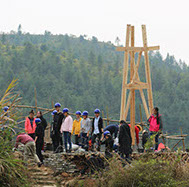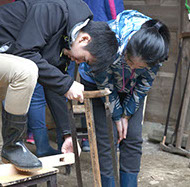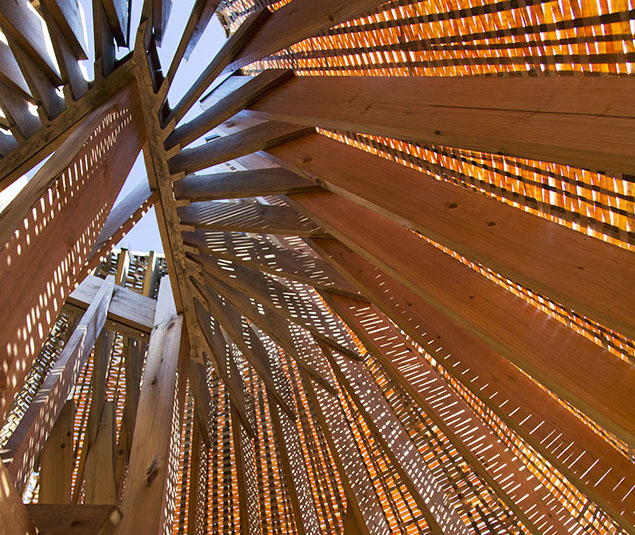
Peitian village in Fujian province used to have ‘tea houses’ dotted around its countryside. In these shelters, made from timber, clay, straw and other materials and often ornately decorated, farmers would eat lunch, take cover from the rain or sun, store materials, or simply gaze upon the scenic fields and hills. The bucolic image changed with the advent of cheap concrete and steel that saw the traditional tea houses replaced with concrete boxes. But in 2017, Donn Holohan and his students attempted to turn back the clock with the help of an 85-year-old craftsman.
They paid three visits to the village to re-construct a tea house – which they dubbed the Sun Room – using a combination of computer and robotic inputs and the dying craft of bamboo weaving.
“The Faculty of Architecture has been doing reconstruction projects in Peitian for several years and we have come to understand that aside from the pressing issue of village regeneration, there is an equally urgent crisis underway – the decline of traditional crafts and trades and the significant loss of intangible cultural heritage that that represents,” Mr Holohan said.
“Our primary driver with this project is to look at how we can preserve that craft and heritage, modernise it and add value to it.”
The project also provided experiential learning for 64 first-year students and two postgraduate students, who were tasked with building a simple structure that nonetheless involved a number of complexities.
First was the site. In deciding the layout of the tea house, they had to be careful not to block the views of tombs and ancestral holds in the area. “There were a lot of debates with the village head and the community about the placement. Their requirements were very codified and indecipherable, but that was more about trying to reach a consensus and involve as many people in the process as possible. This is something we don’t often do in Western architecture,” Mr Holohan said.
Second, the design had to be easily reproducible in other contexts. After students helped form the site with a concrete base and stone wells, they returned to HKU and were involved in figuring out the design using CAD software. The Faculty’s robotics laboratory was used to manufacture the frame, which was put together by students during a second visit to Peitian.
Yongki Sunarta was one of those students and said he enjoyed learning about the philosophy underpinning the village’s architectural structures and the hand-on practicalities of construction work. “This was also about teamwork and hard work – it’s really important to communicate with each other on projects like this, otherwise they simply won’t work,” he said.
The villagers have shown their appreciation by sending Mr Holohan videos on WeChat showing them having parties in the Sun Room, in addition to its other uses as a peaceful shelter in Peitian’s valley – thus fulfilling the goal of breathing new life into old architectural forms.
“China is modernising so drastically, so fast, and I don’t think people really understand what we’re losing, although they have an idea that we’re losing something. Our goal is to mine these crafts and trades and pieces of culture for their usability and potential to add diversity to the built environment, and use them as a resource. Otherwise they will just disappear,” he said.
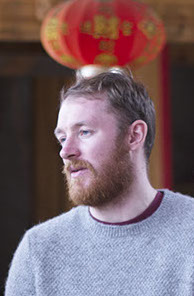
![]() China is modernising so drastically, so fast, and I don’t think people really understand what we’re losing, although they have an idea that we’re losing something. Our goal is to mine these crafts and trades and pieces of culture for their usability and potential to add diversity to the built environment, and use them as a resource.
China is modernising so drastically, so fast, and I don’t think people really understand what we’re losing, although they have an idea that we’re losing something. Our goal is to mine these crafts and trades and pieces of culture for their usability and potential to add diversity to the built environment, and use them as a resource. ![]()
Mr Donn Holohan
Weaving in tradition
That left the defining touch: the bamboo weaving. The 85-year-old was the only one in the village who was skilled in splitting the bamboo, preparing the canes and weaving them together. Mr Holohan and a small team sat alongside him to study his craft. “We had to learn these skills and figure out how to simplify them so we could train others,” he said. The meeting of two worlds – modern international architects and village craftsman – was not always easy. “There was a language barrier and he just wanted us to be quiet and do the work. He was doing it the same way it had been done in the past, so when we wanted to change the scale, from a basket or mat to 55 square metres of material, it was a bit of a shock to him.”
However, the experience also inspired the bamboo weaver to take on apprentices in the village, who then helped train students.
PAST AND PRESENT MEET IN THE SUN ROOM
Traditional architectural crafts and practices are dying out in China. A project in the Faculty of Architecture is trying to save them.
The Sun Room is a community space that provides a respite for villagers who work the land in the hot growing season. The form and siting of the shelter are carefully considered to maximise ventilation and view and to respect protected viewsheds that are a major feature of the landscape.
The Sun Room project took more than 60 HKU students to southern Fujian to aid in the construction. Students and local villagers worked with the last remaining bamboo weaver in Peitian village to re-learn, adapt, and evolve this traditional process.
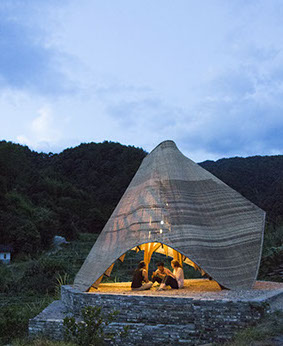
The Sun Room is an in-situ composite woven bamboo shell, which explores the potential of digital design and fabrication techniques to reinvigorate traditional craft.
